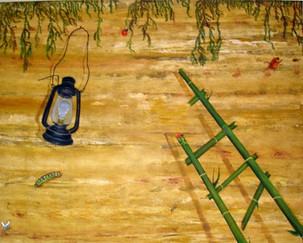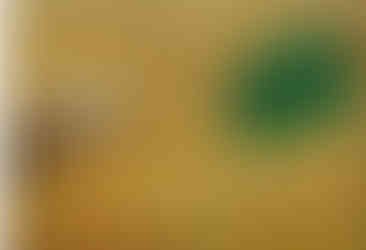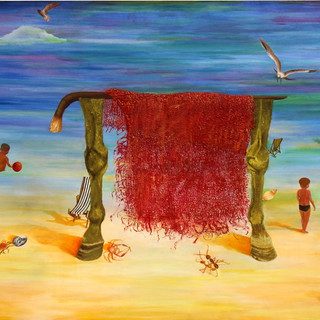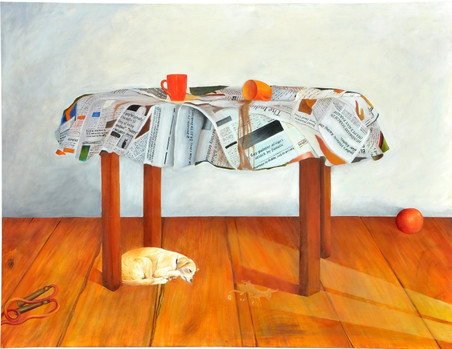Textural Magnificence of Memories: Geetha Ramasesh
- artamour

- Oct 23, 2021
- 9 min read

Hailing from Bangalore, Geetha Ramasesh is a Delhi-based artist. She has held solo shows at the India Habitat Centre, New Delhi and Taj Palace Hotel, New Delhi, and participated in shows at Delhi, Chandigarh, Chennai and a show at Jennet Kennedy Art Center, Dallas, USA. She is a recipient of the Amrita Sher-Gil award in 2014 and the Agnipath Award (twice in 2013 and 2014). She has been doing commissioned work for US clients. Her show at Visual Arts Gallery showcased her latest works in 2019.

1. When did you decide and what prompted you to become an artist? Please give a brief account of your challenges and struggles in your journey as an artist. Any role models?
GR: I belong to a family of painters, musicians and sportspersons. I spent my childhood in a beautiful heritage house surrounded by acres of trees and lovely colourful insects and birds and the memories are still with me. Consciously or unconsciously my childhood influence of growing up in the lap of nature emerges in my paintings. I just paint my mind out without visible references – I know why I paint and what I paint.
I know why I painted heritage buildings, why I paint wood textures, interior of houses and work with gunny rag impressions (a product of a tree). Painting my memories gives me happiness. Tiny colourful creatures liven up my canvas and make my life colourful too.
As a young child along with artists of my family I often visited artist Venkatappa, a painter, sculptor and an exponent of the veena (an Indian classical musical instrument). Though I admired his work I never thought I will become a serious full-time painter one day. Old Bangalore, where I spent my childhood, was culturally and academically very rich. I attended a nearby art class along with a family member and did a few sketches – to my surprise it was displayed for the annual show of that class. At that stage I never thought of becoming an artist. My interest turned towards sports and I went on to become India No 2 (Junior) in table tennis, and represented Karnataka state for 12 years. I was extremely determined in whatever I did.
I shifted to Delhi when I got married to a Supreme Court advocate. Delhi seemed a concrete jungle to me. I faced challenge after challenge along with adjusting to the new city and the harsh climate compared to Bangalore. It was a cultural shock and took a while to adjust. My mind always longed to create something to feel good and to find solace. I started sketching and painting on fine pottery which I had seen a family member doing and converted painted pots into table lamps.
During this period I sketched buildings, trees, animals and even human figures. I often spent hours in railway stations where I could find people waiting for long hours in interesting positions. I also visited Lodi Gardens where I could find people resting and sleeping on benches. I soon developed an urge to express my feelings through art.
It was my good fortune to be staying close to the Garhi Studio in East of Kailash and I started visiting the studio frequently as it had a large open space. I found sculptors and painters working in their studio and sketching under the trees. It was a great place for art lovers. I went there many times, even during peak summers, as it nourished my mind. There I came in contact with the famous print-maker and painter K.R. Subbanna who encouraged me to do more and more sketches and advised me to exhibit my pottery at Triveni Kala Sangam. I finally landed there and whatever I am today is because of that place. It was a great place to pursue my interest seriously and under the guidance of eminent artist Rameshwar Broota I understood the intricacies of art. My visiting galleries in Europe and USA also enriched my experience and inspired me.
My earliest role model was the Dutch artist, Johannes Vermeer, who specialized in domestic interior scenes of middle-class life. I painted a series on the crafts museum in Delhi, inspired by Vermeer’s light and shadow, which is now in possession of a farm house in Mysore. Ancient buildings reflect a style and period in history and a particular human character. I wondered at times why I’m painting different styles but when I saw Picasso’s realistic portrayals I understood that every artist evolves and there is no need to stick to the same style.
Craft Museum series
My art journey has already begun. An artist’s mind is never at rest. I’ve created different series at different times; my childhood experience of the environment is strong in whatever I paint. I converted the canvas to make it look like wood and painted on it. Colourful insects and twigs are also part of my paintings. Gunny rag which comes from the coconut tree and the impression of it on canvas occupied a very important place in my latest show. I started experimenting with different textures on canvas after my visits to Europe and USA galleries, which expanded my imagination. The master of surrealism, Salvador Dali, became my role model and I had the good fortune to attend his solo show at Rome. I’m inspired by his quote, “Intelligence without ambition is like a bird without wings.” My head spins if I look at Dali’s paintings for a long time as they are so brilliant. His childhood experience of spending time near the seaside and his arrangement of small elements are strong in his paintings.
2. What art projects are you working on currently? What is your inspiration or motivation for this?
GR: Driven by an innate, compulsive desire to create and experiment new colours and textures, I keep busy all the time. My recent works are six paintings in shades of grey. I’m presently working on a 8’ x 7’ feet canvas for a client in the US after which I will do another work, which is again a large one for another client. I have spent years struggling to create rag impressions on canvas; I’ve finally succeeded and now the urge to use the technique on a very large canvas.
I take inspiration looking at the variety of art, so for me visiting art galleries is a must as it liberates my soul, makes me think , smile and motivates me in my creative path. I believe that the more you paint the more you develop. I paint all that I have gathered as a child. Simple elements that surround us and go unnoticed in daily life are the most beautiful and have a powerful influence in my life. Here I would like to add that even though I admire many styles of art I enjoy composing in my own style and working on it till I am satisfied.
An earlier work, Roots (see below), is based on the Bhagavad Gita, which I studied to understand why roots are up and the branches down. Branches, leaves and flowers are temporary and fragile and weak; they change colour, shape and fall and grow again, they are weak and fragile. They are like our personality and character which often undergoes change. Roots on the other hand are the strongest, taking energy from Lord Brahma and supplying strength to the entire tree – Brahma here is the sun which nourishes the entire universe.

Roots Up, 6' x 4'
3. Contemporary art has become very diverse and multidisciplinary in the last few decades. Do you welcome this trend? Is this trend part of your art practice?
GR: I do welcome contemporary art. Along with personal expression, contemporary art allows the artist to communicate about the culture around them with imaginary shapes and other varied methods and materials. Artists start a dialogue with viewers by reflecting society,
Contemporary art should be encouraged as it has no distinct feature or a single characteristic and this is what art is – art has no rules. It is defined as an artist’s ability to innovate and bring out a contemporary masterpiece.
The contemporary artist's imagination has no boundaries and they create beautiful art out of nothing and everything. Anish Kapoor explains this in a beautiful way, “A hole is a space full of what isn’t there.”
My art has undergone changes – from canvas, paint and brush to wood texture to gunny rag threads to planting gunny rag impressions on the canvas. An artist can never predict what he will create five years from now. Contemporary art has so far not influenced my art but the artist's mind can never be predicted. I strongly feel my art is progressing well and I will continue to enrich it.
Wood texture works in different sizes, Oil on canvas
Gunny rag experimental works, various sizes, Oil on canvas and at times Mixed media
4. Does art have a social purpose or is it more about self-expression?
GR: Art is a means of self-expression and helps a person convey emotions that are difficult to verbalize. Artists have started sending messages to society through their artworks. They bring out their strong feelings about any kind of injustice in society. They paint political, social, climate change issues but I wonder how much of this influences the viewer’s mind. I do feel very strongly about certain issues like climate change, child abuse, corruption, education, etc. but I prefer to write on these issues rather paint them.
My paintings do not send any messages to society. I even refrain from giving a title to my paintings as I want viewers to form their own opinion and take home something different from my paintings.
5. Where do you create your art (workplace / studio)? What is your process?
GR: The process of creation starts in my mind months before I sit in front of canvas. I make rough sketches which change often. Once I’ve decided on a composition, it starts working in my mind . . . the size, colours, materials, and so on. The picture I create in my mind may not appear the same on canvas, so it undergoes changes at different levels. My works with rag impressions on canvas took about four years of hard work. I discarded more than a dozen canvases during my experiment. I need a very large space as I cannot move the un-stretched canvas for about a month on which I create the impression with gunny rag. Once I separate gunny from the canvas, I again allow the impression to dry completely. I work with paint and thin brush to get the desired shades and paint on it the required object. I’ve moved on from just natural gunny colour to coloured gunny rag. I’ve also introduced print to support my idea and acrylic along with oil paint. One thing has led to another and finally I've started pasting a few gunny threads also on canvas.
At one time, newspapers and books became my subject and I started using them in my compositions.
Newspaper series of works, various sizes, Oil on canvas works and at times Mixed Media works
My latest works are six small canvases in shades of grey. At present I am working on a very large canvas with shades of grey along with adding bright colours.

16" x 16" each, displayed together
I work at home. I’ve a fairly large space and I would like my canvas to be in front of me all the time as ideas strike at any time of day or night. It is difficult to control the self from not painting when an idea strikes. I sometimes work at 4 am in the morning or late at night.

6. To what extent will the world of art change in the post-Covid period – both in terms of what is created as also the business of art?
GR: The art world is reeling from the impact of lockdowns and social distancing. There has been a dip in sales and young artists who were banking on art sales have been very disappointed. The pandemic has had a sudden and substantial impact on art institutions and galleries have been indefinitely shut down. No one is sure how things will shape up in the future. Many show cancellations have taken place and artists are severely hit. It is difficult for an artist not to paint. Many galleries now have online viewing and artists are resorting to social media for showcasing their works.
Collectors now prefer to interact with a piece of art before investing. They have opted to use auction houses to sell art online, which has been hastened by the pandemic. Online auctions have already become effective and were successful during the pre-pandemic time; in fact, the process of selling art through the net is showing positive results with the help of social media.
The art industry is adapting to the new rules of the Covid protocols and making an effort to bring the audience back through an engagement with art aficionados.
7. Tell us about any other interest you may have besides your art practice. Does it get reflected
in your art?
GR: I have been spending most of my time with my painting listening to classical music. I love writing and I never miss my meditation. I’ve learnt meditation systematically and it gives me mental strength and concentration. I love gardening and spending time with plants – I talk to them and they do respond. I like silence and want to be with myself as much as possible. I have learned Hindustani light classical music and sing to myself.
(All images and videos are courtesy of the artist, Geetha Ramasesh)
The artamour questionnaire is a regular series of interviews with visual artists across disciplines, who share their views about art, their practice and their worldview on a common questionnaire template. Like, comment, share and subscribe to stay updated.






















































Comments